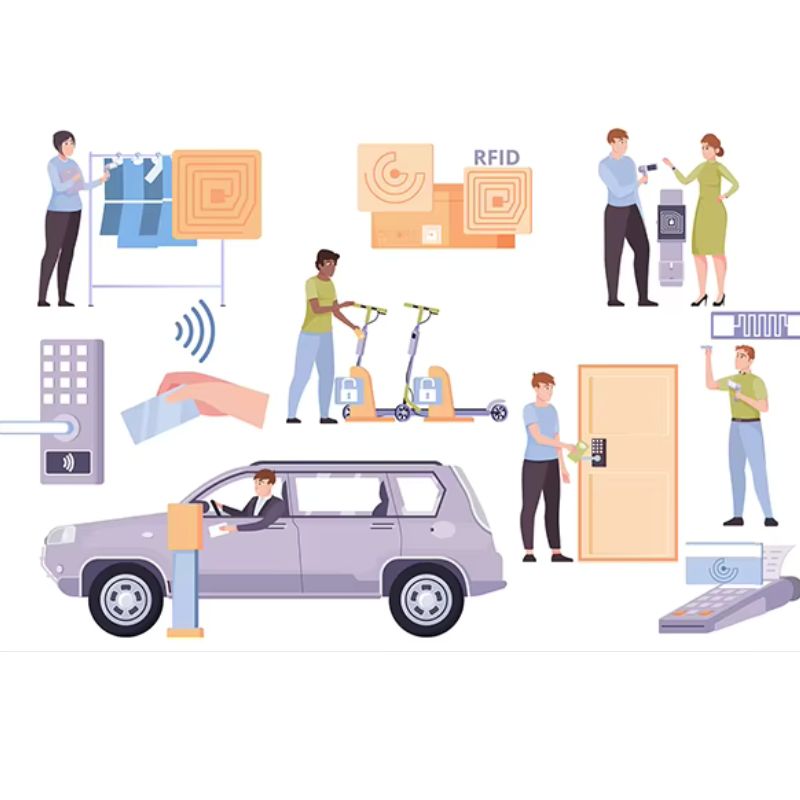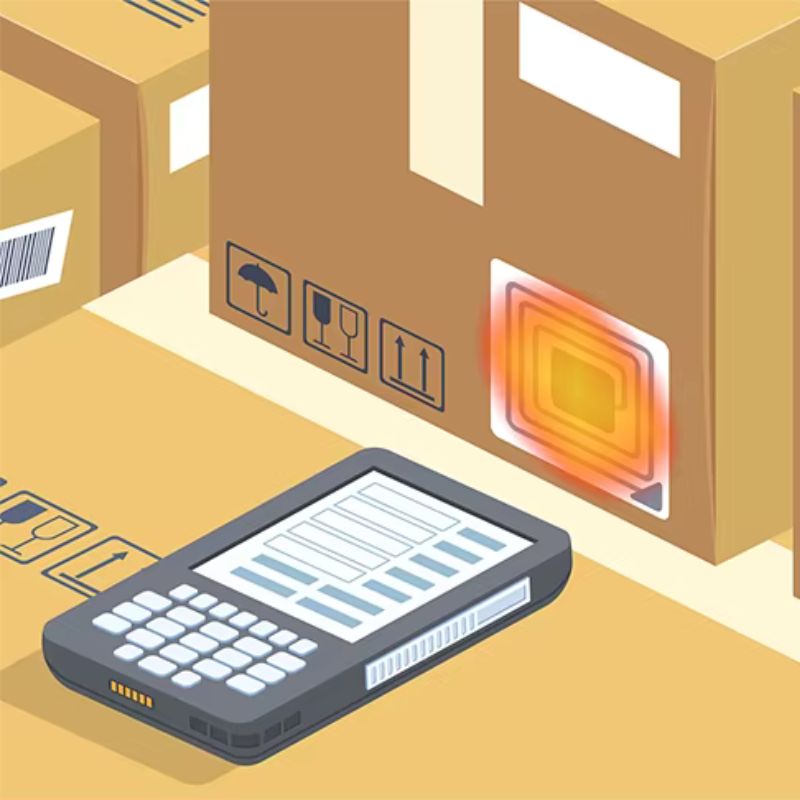Table of Contents
How RFID Technology Revolutionizes Inventory Management Systems
RFID inventory systems provide a powerful upgrade—delivering fast, accurate, and real-time tracking across the entire supply chain. In this guide, we’ll walk you through how to implement and optimize RFID inventory management, step by step, based on real-world experience in retail, logistics, and manufacturing environments.

What Is RFID Inventory Management?
RFID inventory management uses radio-frequency-enabled tags to automatically track items in real time, without needing manual scanning or line-of-sight access.
Core Components:
- RFID Tags: Attached to inventory items (passive, active, or on-metal tags)
- RFID Readers: Devices that wirelessly read tag data
- Antenna: Capture and transmit signals
- RFID Middleware or WMS Integration: Translates tag data into usable inventory records
How to Use RFID Tags for Inventory Management: A Step-by-Step Guide
Step 1: Define Your RFID Inventory Tracking Goals
Ask questions like:
- Are you tracking individual items, bins, pallets, or containers?
- Do you need real-time updates or periodic scanning?
- Is your environment challenging (e.g., metal, liquids, outdoor)?
📌 Tip: Align RFID goals with warehouse KPIs: shrinkage reduction, faster audits, or improved stock accuracy.
Step 2: Select the Right RFID Tags
Choose tags based on:
| Criteria | Recommended Tag Type |
|---|---|
| Standard items on shelves | Passive UHF tags |
| Metal containers or machinery | On-metal RFID tags |
| Items in harsh environments | Rugged, industrial-grade tags |
| High-value assets | Active RFID tags |
📌 Tip: Always test tags in your actual environment before full deployment.
Step 3: Set Up RFID Readers and Antennae
Common placement points include:
- Warehouse entrances/exits
- Loading docks
- Storage zones or bin locations
- Conveyor lines
- Mobile RFID handheld devices
📌 Tip: Reader configuration (power level, directionality) matters. Avoid signal overlap or dead zones.
Step 4: Integrate With Your RFID Inventory Management Software
You’ll need RFID middleware or integration with:
- ERP systems (e.g., SAP, Oracle)
- Warehouse Management Systems (WMS)
- Custom dashboards for tracking and analytics
📌 Tip: Ensure your software can handle real-time data ingestion, not just batch processing.
Step 5: Tag and Map Your RFID Inventory
Apply RFID tags to:
- Products
- Pallets
- Bins or containers
- Fixed shelving units (for location tracking)
Map each tag’s unique ID to the correct SKU or location in your software.
📌 Tip: Use standard tag naming conventions (e.g., GS1 EPC) for interoperability.
Step 6: Test, Calibrate, and Go Live
Before going live:
- Run controlled tests (scan zones, tag reads, reporting accuracy)
- Calibrate reader power levels and positioning
- Train staff on using RFID readers or handhelds
- Monitor data accuracy during trial runs
📌 Tip: Implement in phases—start with one warehouse zone before scaling.
Benefits of RFID Inventory Management
| Advantage | Impact |
|---|---|
| 📦 Real-time visibility | Know exact item location at any moment |
| 🚀 Faster stocktaking | Scan 100s of items in seconds—no line of sight needed |
| ✅ Improved accuracy | Reduces human errors and shrinkage |
| 💰 Labor efficiency | Less manual scanning, faster fulfillment |
| 📊 Better analytics | Insights for reorder points, demand forecasting, stock movement |
RFID vs Barcode in Inventory Tracking
| Feature | RFID | Barcode |
|---|---|---|
| Line of sight needed? | ❌ | ✅ |
| Read multiple items at once? | ✅ | ❌ |
| Tag durability | High (resistant to wear, weather) | Low |
| Cost per tag | Higher | Lower |
| Long-term ROI | High (reduced labor, loss prevention) | Moderate |
Real-World Example: RFID in Retail Inventory
A mid-sized apparel retailer deployed passive RFID tags across 30 stores. Results:
- Inventory count time dropped 80%
- Stock accuracy improved from 70% to 98%
- Out-of-stock incidents reduced by 50%
📌 Insight: Retailers using RFID can perform weekly full-store inventory counts in under 2 hours, vs. once-a-month cycle counts with barcodes.

FAQs About RFID Technology for Inventory Management
Can I use RFID with metal shelving?
Yes, but you’ll need on-metal tags and careful reader placement to avoid interference.
Are RFID tags reusable?
Passive RFID tags can be reused in closed-loop systems, especially when applied to containers or bins.
Do I need internet connectivity?
Not necessarily. Many RFID systems work on local networks and sync to cloud platforms only when needed.
Need Help Deploying RFID for Inventory?
At JIA RFID, we help retailers, warehouses, and manufacturers design, deploy, and scale RFID inventory systems that save time and money.
👉 Contact us for a free consultation →

Ray Zhou
This article was written by Ray Zhou, an RFID technology expert with more than 10 years of industry experience.
Comments
Hot Products

RFID in Logistics: How to Eliminate RFID Misrouting and RFID Label Failures
RFID in logistics is more than just a tool to speed up processes. It has become a key part of how modern supply chains operate.

What Is RFID Waste Management
Imagine a city where every trash bin speaks — not literally — but through a tiny chip that tells the system when it’s full, when it’s emptied, and where it went. That’s what RFID waste management is doing today.

What are Bolt Seals and their Applications? | Complete Guide
In global trade and logistics, bolt seals play a crucial role in ensuring cargo security and compliance. These small but powerful devices are designed to lock shipping containers, trailers, and cargo doors with a tamper-evident mechanism.

What is an RFID Card Protector? Benefits, Use Cases, and Buying Guide
RFID technology (Radio Frequency Identification) is everywhere: in your credit cards, ID badges, transit passes, hotel room keys, and more. It offers speed and convenience, but it also opens the door to a new kind of digital theft called “skimming.” That’s where an RFID card protector comes in.

RFID Wristbands for Events: Bulk Buying Guide for Organizers
RFID wristbands for events are becoming the go-to solution for organizers who need faster entry, fraud prevention, and cashless payments at concerts, festivals, and sports venues. Unlike paper tickets or QR codes, these smart wristbands use embedded chips to streamline access, secure transactions, and improve the guest experience.

How RFID Tag on Windscreen Improves Vehicle Access Control and Toll Systems
In today’s fast-paced world, vehicle identification needs to be quick, secure, and contactless. An RFID Tag on the Windscreen provides exactly that — a reliable way to manage toll collection, parking, and gated access without stopping vehicles.
Tags
RELATED BLOGS

RFID in Logistics: How to Eliminate RFID Misrouting and RFID Label Failures
RFID in logistics is more than just a tool to speed up processes. It has become a key part of how modern supply chains operate.

What Is RFID Waste Management
Imagine a city where every trash bin speaks — not literally — but through a tiny chip that tells the system when it’s full, when it’s emptied, and where it went. That’s what RFID waste management is doing today.

What are Bolt Seals and their Applications? | Complete Guide
In global trade and logistics, bolt seals play a crucial role in ensuring cargo security and compliance. These small but powerful devices are designed to lock shipping containers, trailers, and cargo doors with a tamper-evident mechanism.





